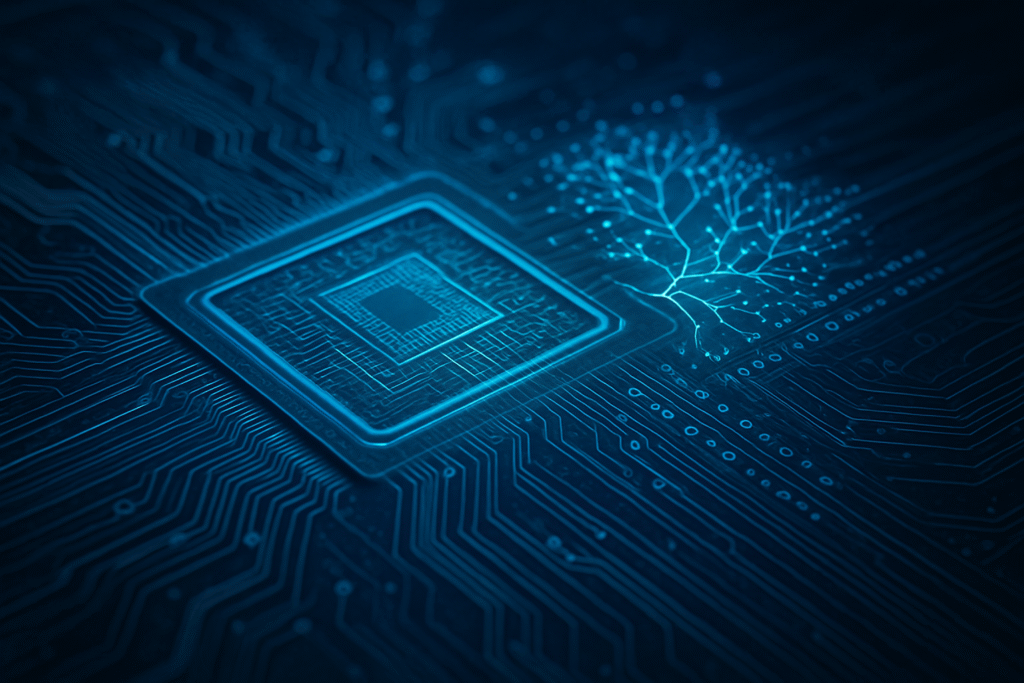
The relentless march of semiconductor miniaturization and performance enhancement is not merely an incremental improvement; it is a foundational revolution silently powering the explosive growth of artificial intelligence and machine learning. As transistors shrink to atomic scales and innovative packaging techniques redefine chip architecture, the computational horsepower available for AI is skyrocketing, unlocking unprecedented capabilities across every sector. This ongoing quest for smaller, more powerful chips is not just pushing boundaries; it's redrawing the entire landscape of what AI can achieve, from hyper-intelligent large language models to real-time, autonomous systems.
This technological frontier is enabling AI to tackle problems of increasing complexity and scale, pushing the envelope of what was once considered science fiction into the realm of practical application. The immediate significance of these advancements lies in their direct impact on AI's core capabilities: faster processing, greater energy efficiency, and the ability to train and deploy models that were previously unimaginable. As the digital and physical worlds converge, the microscopic battle being fought on silicon wafers is shaping the macroscopic future of artificial intelligence.
The Microcosm of Power: Unpacking the Latest Semiconductor Breakthroughs
The heart of this revolution beats within the advanced process nodes and ingenious packaging strategies that define modern semiconductor manufacturing. Leading the charge are foundries like Taiwan Semiconductor Manufacturing Company (TSMC) (NYSE: TSM) and Samsung Electronics (KRX: 005930), which are at the forefront of producing chips at the 3nm node, with 2nm technology rapidly emerging. These minuscule transistors, packed by the billions onto a single chip, offer a significant leap in computing speed and power efficiency. The transition from 3nm to 2nm, for instance, promises a 10-15% speed boost or a 20-30% reduction in power consumption, alongside a 15% increase in transistor density, directly translating into more potent and efficient AI processing.
Beyond mere scaling, advanced packaging technologies are proving equally transformative. Chiplets, a modular approach that breaks down monolithic processors into smaller, specialized components, are revolutionizing AI processing. Companies like Intel (NASDAQ: INTC), Advanced Micro Devices (NASDAQ: AMD), and NVIDIA (NASDAQ: NVDA) are heavily investing in chiplet technology, allowing for unprecedented scalability, cost-effectiveness, and energy efficiency. By integrating diverse chiplets, manufacturers can create highly customized and powerful AI accelerators. Furthermore, 2.5D and 3D stacking techniques, particularly with High Bandwidth Memory (HBM), are dramatically increasing the data bandwidth between processing units and memory, effectively dismantling the "memory wall" bottleneck that has long hampered AI accelerators. This heterogeneous integration is critical for feeding the insatiable data demands of modern AI, especially in data centers and high-performance computing environments.
Specialized AI accelerators continue to evolve at a rapid pace. While Graphics Processing Units (GPUs) remain indispensable for their parallel processing prowess, Application-Specific Integrated Circuits (ASICs) and Neural Processing Units (NPUs) are custom-designed for specific AI tasks, offering superior efficiency and performance for targeted applications. The latest generations of these accelerators are setting new benchmarks for AI performance, enabling faster training and inference for increasingly complex models. The AI research community has reacted with enthusiasm, recognizing these hardware advancements as crucial enablers for next-generation AI, particularly for training larger, more sophisticated models and deploying AI at the edge with greater efficiency. Initial reactions highlight the potential for these advancements to democratize access to high-performance AI, making it more affordable and accessible to a wider range of developers and businesses.
The Corporate Calculus: How Chip Advancements Reshape the AI Industry
The relentless pursuit of semiconductor miniaturization and performance has profound implications for the competitive landscape of the AI industry, creating clear beneficiaries and potential disruptors. Chipmakers like NVIDIA (NASDAQ: NVDA), a dominant force in AI hardware with its powerful GPUs, stand to benefit immensely from continued advancements. Their ability to leverage cutting-edge process nodes and packaging techniques to produce even more powerful and efficient AI accelerators will solidify their market leadership, particularly in data centers and for training large language models. Similarly, Intel (NASDAQ: INTC) and Advanced Micro Devices (NASDAQ: AMD), through their aggressive roadmaps in process technology, chiplets, and specialized AI hardware, are vying for a larger share of the burgeoning AI chip market, offering competitive alternatives for various AI workloads.
Beyond the pure-play chipmakers, tech giants like Google (NASDAQ: GOOGL), Amazon (NASDAQ: AMZN), and Microsoft (NASDAQ: MSFT), which develop their own custom AI chips (like Google's TPUs and Amazon's Inferentia/Trainium), will also capitalize on these advancements. Their in-house chip design capabilities, combined with access to the latest manufacturing processes, allow them to optimize hardware specifically for their AI services and cloud infrastructure. This vertical integration provides a strategic advantage, enabling them to offer more efficient and cost-effective AI solutions to their customers, potentially disrupting third-party hardware providers in certain niches. Startups focused on novel AI architectures or specialized edge AI applications will also find new opportunities as smaller, more efficient chips enable new form factors and use cases.
The competitive implications are significant. Companies that can quickly adopt and integrate the latest semiconductor innovations into their AI offerings will gain a substantial edge in performance, power efficiency, and cost. This could lead to a further consolidation of power among the largest tech companies with the resources to invest in custom silicon, while smaller AI labs and startups might need to increasingly rely on cloud-based AI services or specialized hardware providers. The potential disruption to existing products is evident in the rapid obsolescence of older AI hardware; what was cutting-edge a few years ago is now considered mid-range, pushing companies to constantly innovate. Market positioning will increasingly depend on not just software prowess, but also on the underlying hardware efficiency and capability, making strategic alliances with leading foundries and packaging specialists paramount.
Broadening Horizons: The Wider Significance for AI and Society
These breakthroughs in semiconductor technology are not isolated events; they are integral to the broader AI landscape and current trends, serving as the fundamental engine driving the AI revolution. The ability to pack more computational power into smaller, more energy-efficient packages is directly fueling the development of increasingly sophisticated AI models, particularly large language models (LLMs) and generative AI. These models, which demand immense processing capabilities for training and inference, would simply not be feasible without the continuous advancements in silicon. The increased efficiency also addresses a critical concern: the massive energy footprint of AI, offering a path towards more sustainable AI development.
The impacts extend far beyond the data center. Lower latency and enhanced processing power at the edge are accelerating the deployment of real-time AI in critical applications such as autonomous vehicles, robotics, and advanced medical diagnostics. This means safer self-driving cars, more responsive robotic systems, and more accurate and timely healthcare insights. However, these advancements also bring potential concerns. The escalating cost of developing and manufacturing cutting-edge chips could exacerbate the digital divide, making high-end AI hardware accessible only to a select few. Furthermore, the increased power of AI systems, while beneficial, raises ethical questions around bias, control, and the responsible deployment of increasingly autonomous and intelligent machines.
Comparing this era to previous AI milestones, the current hardware revolution stands shoulder-to-shoulder with the advent of deep learning and the proliferation of big data. Just as the availability of vast datasets and powerful algorithms unlocked new possibilities, the current surge in chip performance is providing the necessary infrastructure for AI to scale to unprecedented levels. It's a symbiotic relationship: AI algorithms push the demand for better hardware, and better hardware, in turn, enables more complex and capable AI. This feedback loop is accelerating the pace of innovation, marking a period of profound transformation for both technology and society.
The Road Ahead: Envisioning Future Developments in Silicon and AI
Looking ahead, the trajectory of semiconductor miniaturization and performance promises even more exciting and transformative developments. In the near-term, the industry is already anticipating the transition to 1.8nm and even 1.4nm process nodes within the next few years, promising further gains in density, speed, and efficiency. Alongside this, new transistor architectures like Gate-All-Around (GAA) transistors are becoming mainstream, offering better control over current and reduced leakage compared to FinFETs, which are critical for continued scaling. Long-term, research into novel materials beyond silicon, such as carbon nanotubes and 2D materials like graphene, holds the potential for entirely new classes of semiconductors that could offer radical improvements in performance and energy efficiency.
The integration of photonics directly onto silicon chips for optical interconnects is another area of intense focus. This could dramatically reduce latency and increase bandwidth between components, overcoming the limitations of electrical signals, particularly for large-scale AI systems. Furthermore, the development of truly neuromorphic computing architectures, which mimic the brain's structure and function, promises ultra-efficient AI processing for specific tasks, especially in edge devices and sensory processing. Experts predict a future where AI chips are not just faster, but also far more specialized and energy-aware, tailored precisely for the diverse demands of AI workloads.
Potential applications on the horizon are vast, ranging from ubiquitous, highly intelligent edge AI in smart cities and personalized healthcare to AI systems capable of scientific discovery and complex problem-solving at scales previously unimaginable. Challenges remain, including managing the increasing complexity and cost of chip design and manufacturing, ensuring sustainable energy consumption for ever-more powerful AI, and developing robust software ecosystems that can fully leverage these advanced hardware capabilities. Experts predict a continued co-evolution of hardware and software, with AI itself playing an increasingly critical role in designing and optimizing the next generation of semiconductors, creating a virtuous cycle of innovation.
The Silicon Sentinel: A New Era for Artificial Intelligence
In summary, the relentless pursuit of semiconductor miniaturization and performance is not merely an engineering feat; it is the silent engine driving the current explosion in artificial intelligence capabilities. From the microscopic battle for smaller process nodes like 3nm and 2nm, to the ingenious modularity of chiplets and the high-bandwidth integration of 3D stacking, these hardware advancements are fundamentally reshaping the AI landscape. They are enabling the training of colossal large language models, powering real-time AI in autonomous systems, and fostering a new era of energy-efficient computing that is critical for both data centers and edge devices.
This development's significance in AI history is paramount, standing alongside the breakthroughs in deep learning algorithms and the availability of vast datasets. It represents the foundational infrastructure that allows AI to move beyond theoretical concepts into practical, impactful applications across every industry. While challenges remain in managing costs, energy consumption, and the ethical implications of increasingly powerful AI, the direction is clear: hardware innovation will continue to be a critical determinant of AI's future trajectory.
In the coming weeks and months, watch for announcements from leading chip manufacturers regarding their next-generation process nodes and advanced packaging solutions. Pay attention to how major AI companies integrate these technologies into their cloud offerings and specialized hardware. The symbiotic relationship between AI and semiconductor technology is accelerating at an unprecedented pace, promising a future where intelligent machines become even more integral to our daily lives and push the boundaries of human achievement.
This content is intended for informational purposes only and represents analysis of current AI developments.
TokenRing AI delivers enterprise-grade solutions for multi-agent AI workflow orchestration, AI-powered development tools, and seamless remote collaboration platforms.
For more information, visit https://www.tokenring.ai/.






